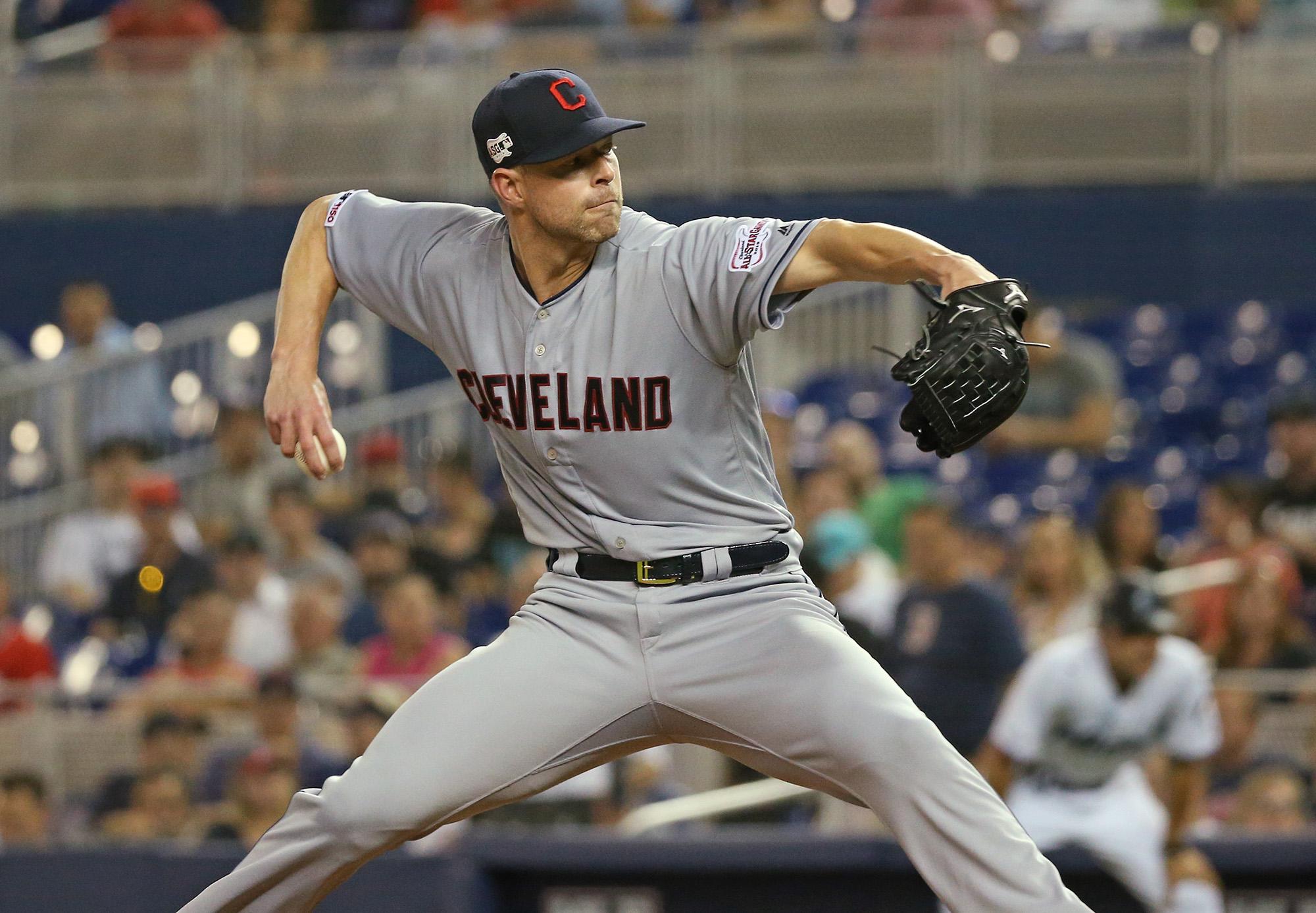
In 2016, Cleveland reached the World Series before blowing a 3-1 lead. In 2017, it won 102 games and set an MLB record (kind of) with 22 consecutive wins before blowing a 2-0 lead against the Yankees in the ALDS. In 2018, it won the division again before losing to Houston in an ALDS sweep.
Playoff disappointments aside, the team looked like a juggernaut in the making, with all the talent necessary to contend for years to come. Francisco Lindor was an ideal franchise cornerstone, a smiling, slick-fielding, power-hitting shortstop with youth and enthusiasm and a full complement of tools. José Ramírez joined Lindor as an MVP candidate, and he had recently signed the most owner-friendly contract extension in baseball. The rotation was one of the best in the sport’s history, with Corey Kluber and Carlos Carrasco leading the charge.
In July 2018, FanGraphs ranked the two infielders first and second overall and Kluber 12th in its annual trade value exercise. Author Kiley McDaniel wrote that thanks to this trio, “Cleveland is leading their division and will likely be doing that a lot in the coming years.”
Or not. After missing the 2019 postseason, the club took a giant, intentional leap backward Sunday, trading Kluber to Texas for young reliever Emmanuel Clase and outfielder Delino DeShields. The trade is a boon for the Rangers, who add a recent two-time Cy Young winner on the cheap; it represents an unmitigated disaster for Cleveland fans, who get to watch their club strip itself for parts in order to save a few bucks, contention—and the franchise’s 71-year title drought—be darned.
For the Rangers, who are on the verge of moving into a new stadium, Sunday’s trade provides a jolt of excitement after the team missed out last week on free agent Anthony Rendon, whom the team had coveted at third base. Kluber doesn’t help the lineup, but he adds much-needed dependability and top-level talent to a rotation that cratered outside its top pair last season.
Mike Minor and Lance Lynn ranked among the most valuable starters in baseball in 2019. The rest of the rotation can make no such claim; all other Rangers starters combined for a 7.22 ERA, which meant Texas received replacement-level production from three rotation spots. They didn’t throw many innings, either, straining the bullpen; Minor and Lynn threw more innings combined than all those who filled rotation spots three through five.
Rangers 2019 Rotation
Kluber joins Minor, Lynn, and free-agent signees Kyle Gibson and Jordan Lyles to give the Rangers five competent, if not better, pitchers, which should launch both the team’s floor and ceiling upward. The back end of Texas’s rotation was so atrocious last season that even average production in 2020 will represent a meaningful improvement, and Kluber in particular has a track record so much better than average.
For Cleveland, well, let’s get the caveats out of the way first before diving into the numerous negatives. It’s possible, for one, that Kluber’s acehood is solely in the past. In 2019, the veteran right-hander suffered a fluke injury when a 102 mph line drive deflected off his forearm, breaking the bone and keeping him off the mound for three months. When he tried to return in August, an oblique strain shut him down again and ended his season early. Before his injury, Kluber made just seven MLB starts and notched an unsightly 5.80 ERA.
Kluber’s velocity has dipped, as is typical of a player entering his mid-30s, from around 94 mph on his fastball a half-decade earlier to 92.4 last season. He walked more batters than ever last season. He was hit harder than before. And he is due to make $17.5 million next season, which would have been the second-highest salary on a franchise that wants to save money.
It is also possible that Clase could develop into a special reliever. The 21-year-old righty throws a unique pitch—a triple-digit four-seamer that moves like a cutter—that could allow him to befuddle batters for years. Cleveland likes its bullpen innovations.
But given the relative importance of starters and relievers, and the value of present versus future production, the only way Cleveland breaks even in this deal is if Clase develops into a perennial All-Star reliever while Kluber falls off completely. The nicest thing to say about DeShields, meanwhile, is that his speed and defensive numbers make him look like a knockoff Billy Hamilton; otherwise, like a knockoff Hamilton, he fits the recent Cleveland tradition of acquiring outfielders who can’t hit. DeShields ranked 460th out of 478 hitters in average exit velocity last season, and his career wRC+ is 24 percent worse than average.
Nor does Clase come to Cleveland with the sort of statistics that might point to future dominance. In 37 2/3 innings in Double-A last season, he struck out 25.5 percent of opposing hitters, barely better than the Texas League average of 24.1 percent. In his first 23 1/3 innings in the majors, his K rate dipped further, to less than the MLB average for relievers, and he posted a subpar swinging-strike rate as well. FanGraphs ranked Clase 19th among Rangers prospects at the end of the season.
Kluber requires no such projection to reward his team with tremendous value. Ever since he joined Cleveland as a relative non-prospect in a 2011 three-team trade, Kluber has ranked among the best pitchers in the sport. In a five-year range from 2014 through 2018, he won two Cy Young awards and finished third twice; in that span, he ranked among the top five starters in ERA, FIP, K-BB%, and WAR, among all manner of impressive statistical markers. And while his 2019 struggles are reason for some caution when forecasting a rosy future, a few factors work in his favor.
First, and most importantly, last year’s injury was a fluke. From 2014 through 2018, Kluber pitched the second-most innings in baseball, passing the 200-inning threshold every year. And though he had perhaps suffered some injuries in the past—most notably, he allowed nine runs in 6 1/3 innings in two starts in the 2017 ALDS amid speculation that he was fighting a back injury, though he downplayed that possible excuse—he never spent more than a month at a time on the injured list or suffered an arm injury before last year.
He also endured unsustainably poor luck on batted balls and strand rate in 2019, so his 5.80 ERA overstates his decline. And because of the injury, all those poor starts amounted to just 35 2/3 ineffective innings—hardly a reason to predict he’s an excessive risk.
That Cleveland seemed eager to move on from its ace reflects, far more than excitement about Clase or concern about Kluber’s mid-30s, a desire to move on from his salary—a darkly ironic consideration, given that in his elite stretch from 2014 through 2018, pitching on an owner-friendly extension, Kluber made just $24.8 million total.
In 2020, Kluber will earn $17.5 million, and now that he’s been traded, his ensuing option means he will earn $18 million in 2021 if he throws at least 160 innings next season and doesn’t finish the year on the IL. But if Kluber is healthy next season, he’ll almost surely be good again, so the Rangers would likely be thrilled to secure his services for another year at a reasonable price.
Cleveland was evidently not willing to pay that price, which is a seemingly outrageous proposition that nonetheless is born out by the franchise’s recent financial history. It didn’t spend at all last winter, despite glaring holes in the outfield, and thus scuffled to the point that the Twins could race by to the AL Central title. It’s already reportedly shopped Lindor, despite controlling his arbitration rights for the next two seasons. It hasn’t signed a single free agent yet this winter. And now it has turned a beloved staff ace into a backup outfielder and relief prospect, halting by some measure a joyous period of contention that hasn’t yet secured a title—but at least the payroll is down by an eight-figure margin, after already declining from 2018 to 2019.
From an on-field perspective, there is no reason for the team to take a strategic step backward, even after missing the 2019 postseason. Just about everything that could have gone wrong last season did. Ramírez suffered one of the strangest single-season declines in MLB history in 2019, though he bounced back to approximate his usual self in the second half. Kluber was hurt, Mike Clevinger spent two months on the IL with an injury of his own, and Carrasco missed time due to treatment for leukemia. Even with all those setbacks, the club was in contention for a wild-card berth until Game 160.
Cleveland should still contend for a playoff spot in 2020, but Sunday’s trade slimmed the margins considerably. Cleveland boasted the fourth-best projected rotation for next season, per FanGraphs, with Kluber in the fold; without Kluber, it’s now down to no. 9, ironically one spot behind the Rangers. This group won’t collapse next season: Carrasco, Clevinger, and Shane Bieber form a dynamic top three, and the likes of Aaron Civale and Zach Plesac pitched well as rookies in 2019. But that duo should regress given peripheral numbers that didn’t match their ERAs, and removing Kluber saps depth should any of the top quintet struggle or get hurt.
One optimistic view for Cleveland concerns its history of trading Cy Young winners. In July 2008, Cleveland traded CC Sabathia and received Michael Brantley as a prospect in return; in July 2009, it did the same with Cliff Lee and brought back Carrasco. But key contextual differences arise when comparing those deals to this one—namely, Sabathia was three months from free agency when he was traded, Lee just a year and a half, and those Cleveland teams were well out of contention at the time. It made sense for the club to shift competitive timelines.
With Kluber, Cleveland had two full years left with a very good pitcher and a very good team. A few minor tweaks and upgrades—a new second baseman to replace Jason Kipnis, an outfielder who can actually hit—could have returned the team to the top of the division, where Kluber may have been a difference-maker between his team and the pitching-starved Twins.
But ownership apparently decided that after underpaying Kluber for years and reaping the benefits, it would rather not pay him anymore than return to the postseason. Broadly, this offseason has been frenetic and fast-paced, far removed from last season’s slog and a pleasant turn of events for a sport headed toward labor strife.
Sunday’s trade runs counter to that positivity—it exposes in ugly, bold-faced terms exactly what happens when a team decides financial considerations outweigh competitive ones. The Rangers, of course, benefit; they have a new ace for their fans to cheer. Texas is a winner in the deal. The losers? Well, Cleveland’s fans, for one, and the whole rest of the sport, for another, if this is where MLB is headed in the decade to come.

